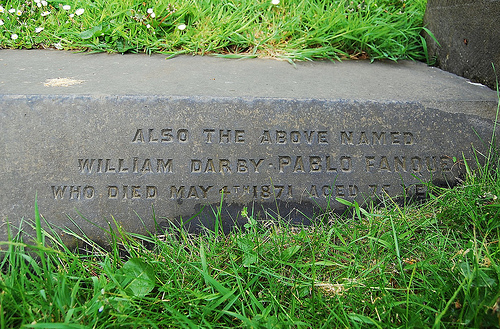While the grave of Eleanor Rigby in Liverpool inspired Paul McCartney, Leeds can boast a grave stone that played a part in the Beatles song writing history. The grave of William Darby a.k.a Pablo Fanque can be found in a quiet part of Woodhouse cemetery. Pablo Fanque had a successful travelling circus in the 1840’s. John Lennon bought one of the posters for the spectacular circus show and wrote the song ‘Being for the benefit of Mr Kite’ on the 1967 Sgt Pepper album. Pablo’s wife Suzanne was killed in a freak accident in 1848 when the big top collapsed whilst they were playing to a large crowd in the Headrow, Leeds. She was buried in Woodhouse cemetery and Pablo was buried alongside her when he died in 1871.

Click here to hear Being for the benefit of Mr Kite
The Sgt Pepper”s album was declared a decisive moment in the history of Western civilization at the time.
‘Being for the benefit of Mr Kite’ was one of 3 songs on the album banned by the B.B.C. The lyrics ‘Henry the horse’ were thought to be slang for Heroin. ”A day in the life’ was banned for the lyrics ‘I’d love to turn you on’ and ‘Lucy in the sky with diamonds’ was banned because the initials spelt out L.S.D.
How times have changed!!
THE WHO. LIVE AT LEEDS!

The Leeds University refectory was the setting for the recording of the finest live album of all time. After releasing the album Tommy in 1969. The Who went on a world tour to promote it. They returned to England with a desire to release a live album from the tour. In typical Who fashion Pete Townshend burned the tapes, as they disapproved of having to listen to 80 hours of recordings to decide which would make the best album. Two shows were scheduled for Leeds University and Hull, specifically to record material for the new album. Technical problems with the recordings from the Hull gig meant that Leeds would go down in music history for the finest live album of all time. The three-hour concert took place on Valentine’s day 1970. Students queued for hours to get a ticket and many who failed took to the roof of the building that evening to hear and feel the music.
The album’s reputation has become so lofty that the venue it was recorded in, the University of Leeds Refectory, has been named a national landmark in the UK and commemorated with a blue plaque.

Solidarity to all strikers in South Yorkshire today! I wish more peolpe would follow your brave example and stand up for their rights. If we all did that, we’d like in a much better world. Solidarity and good luck!